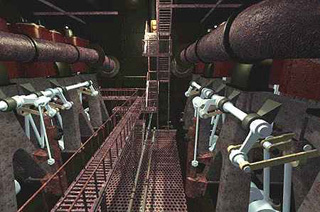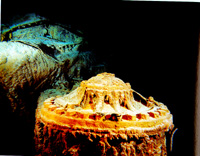In Memoriam: RMS Titanic

The Collision
For economic reasons, liners of the Titanic's era operated under cruising conditions while at sea. This usually meant the reciprocating engines were in the "Full Ahead" position and the turbine was engaged and operating. The change-over procedure for approaching or maneuvering in port involved several steps to divert steam from the turbine and prepare for changes in the operation of the reciprocating engines. This required the activation of several huge valves, which, in, Olympic and Titanic, was accomplished by means of steam powered actuators.
Under normal conditions, the Engine Room was notified thirty minutes prior to the commencement of any maneuvers. Fifteen minutes later the Bridge would place engines under "Stand-By" orders. This allowed sufficient time for the change over especially if there happened to be a malfunction.
When the iceberg was sighted, the bridge reacted instinctively. There was no time for the engineers to prepare themselves or their ship for the drastic maneuver that was attempted. After all, no one expected any change in orders in the middle of the Atlantic Ocean! Since it required several minutes to change from cruising to maneuvering status, it is unlikely there was any appreciable slowing of the ship before she hit the iceberg.
Since none of the engineers survived, we will never know exactly what happened during the 37 seconds from sighting the iceberg to the collision. There is evidence the engineers were not at the controls and that the initial engine commands were answered and responded to by two greasers. Regardless, most scenarios agree steam to the turbine would have been cut off. While this had little effect on the ship's forward motion, it deprived the rudder of the steady, forceful stream of water necessary to turn a ship of that size. Several sources claim the rudder on the Titanic and her sister ships was too small. If that was indeed the case, shutting down the center turbine would be the last thing you would want to do in an emergency.

In any event, Titanic's rudder, like her engines, never had the chance to significantly change the ship's heading before the collision. Tests conducted during the British Inquiry showed that the iceberg could not have been more than 1500 feet away when first sighted. It is also showed that a vessel such as the 880 foot Titanic, running at 21½ knots, would advance a minimum of two full ship lengths before showing any response to her helm. In short, given the speed of the ship and the distance at which the iceberg was sighted, there was no way to avoid a collision.
